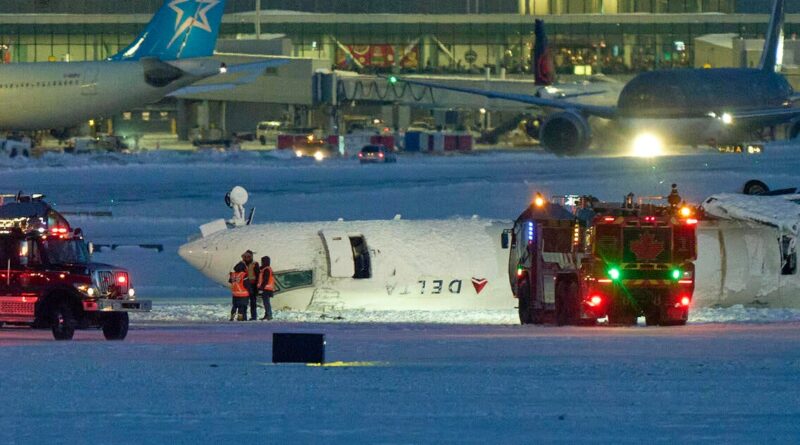Why did the Delta plane crash and flip in Toronto? Here’s what we know about the cause.
A Delta Air Lines jet crashed Monday during a fiery landing at Toronto Pearson International Airport, skidding down the tarmac before coming to a stop while flipped upside down.
The dramatic scene, captured on video by air traffic controllers and, later, the passengers on board, left 21 people injured — two critically. What caused it remains under investigation by the Canadian Transportation Safety Board, which said Tuesday that the aircraft’s black boxes have been recovered, and the U.S. National Transportation Safety Board and Federal Aviation Administration. Here’s what we know so far.
The ceiling of the plane “had become the floor”
Delta Air Lines Flight 4819 departed Minneapolis-St. Paul International Airport in Minnesota on Monday morning, carrying 76 passengers and four crew members.
The plane, operated by Minneapolis-based Delta Air Lines subsidiary Endeavor Air, struck the landing strip as it arrived at Toronto Airport at about 1:15 p.m. CST, according to Delta. Images and video of the accident showed the CRJ-900 aircraft catch fire when it hit the pavement and proceeded to turn sideways while sliding across the airfield, losing its tail and both wings along the way.
It eventually flipped over and came to a halt. Passengers on the plane have since described hanging upside down, suspended by their fastened seatbelts, with one person recalling how he “crashed down onto the ceiling, which had become the floor” after unbuckling.
Emergency teams rushed to the site of the crash, extinguishing the blaze and then evacuating the passengers who were still inside. At a news conference Tuesday, Toronto International Airport president and CEO Deborah Flint praised the Delta flight crew and emergency workers at the airport for launching a “textbook” response to the accident that got underway “within minutes.”
“The crew of Delta Flight 4819 heroically led passengers to safety, evacuating a jet that had overturned on the runway on landing that was amidst, smoke and fire,” Flint said. “Thank you for all that you do every day and every night in service of safe air travel.”
Two people were critically injured
All 80 passengers and crew members on the Delta flight survived the crash. Emergency responders and the flight crew themselves ushered passengers down the aisle of the overturned jet and helped evacuate them through an emergency exit door. More footage from the crash showed passengers climbing out of the aircraft and stepping out onto a snowy tarmac, where powerful winds whipped past.
Officials originally reported that 19 people suffered injuries in the accident, but the number was revised up to 21 between Monday and Tuesday. Flint said 19 people were taken to hospitals in the area for medical treatment immediately after the crash, and two more were admitted later on. Corey Tkatch, commander of operations for Peel Regional Paramedic Services, said some people suffered back sprains, head injuries, anxiety and “nausea and vomiting due to the fuel exposure.”
Nineteen of the injured people had been released by Tuesday, according to Delta Air Lines, while two remained hospitalized and their conditions were listed as critical. The exact nature of their situations has not been publicized, but Flint told reporters the people hurt on Flight 4819 had a range of injuries considered minor to critical, none of which are life-threatening.
Peel Regional Paramedic Services at first classified a child as injured and in critical condition, but the Hospital for Sick Children later said the child was in good condition. Reporters pressed airport officials and responders Tuesday for answers as to whether the two people still hospitalized with critical injuries included any children, but the officials said they did not know.
Toronto was experiencing rough and frigid weather
Evacuees from the plane crash were met with harsh wintry conditions when they exited onto the airfield, with one person likening the environment to tundra weather. Snow and ice coated the tarmac, and powerful, blustery winds could be seen on video.
Meteorologists said Toronto was experiencing blowing snow when the accident occurred, and visibility had been reduced to 6 miles. Winds were gusting up to 37 miles per hour and temperatures dropped far below freezing to just 17 degrees Fahrenheit.
But Toronto International Airport Fire Chief Todd Aitken said Monday that the airport runway was dry at the time of the crash, and there were no crosswind conditions as the Delta flight arrived.
Flint on Tuesday said the crash occurred on “an operational day” at the Toronto airport, which canceled hundreds of flights over the weekend as a result of heavy snowfall. By Monday, more than 1,000 flights were scheduled, and they resumed at the airport just about three hours after the accident.
Almost two dozen members of Transportation Safety Board of Canada are leading an investigation into the crash and what may have caused it. The United States National Transportation Safety Board and Federal Aviation Administration will also send people from both U.S. agencies to assist in the probe.

